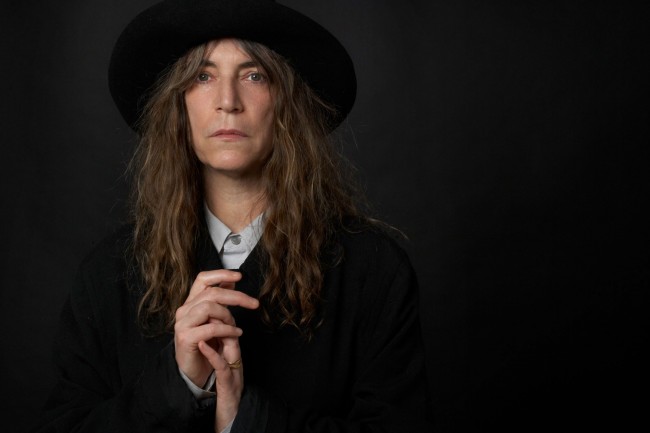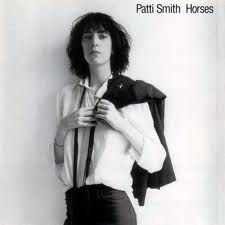JUST PATTI – PATTI SMITH AT MEMORIAL HALL
by Kathy Valin
One Indian summer day we dressed in our favorite things, me in my beatnik sandals and ragged scarves, and Robert with his love beads and sheepskin vest. We took the subway to West Fourth Street and spent the afternoon in Washington Square. We shared coffee from a thermos, watching the stream of tourists, stoners, and folksingers. Agitated revolutionaries distributed antiwar leaflets. Chess players drew a crowd of their own. Everyone coexisted within the continuous drone of verbal diatribes, bongos, and barking dogs.
We were walking toward the fountain, the epicenter of activity, when an older couple stopped and openly observed us. Robert enjoyed being noticed and he affectionately squeezed my hand.
“Oh, take their picture,” said the woman to her bemused husband, “I think they’re artists.”
“Oh, go on,” he shrugged. “They’re just kids.”
– “Just Kids,” Patti Smith
How does a rock star get old? For Patti Smith, who appeared in concert at Cincinnati’s Memorial Hall, sponsored by the Contemporary Arts Center on Saturday, May 18, it appears that she just keeps keeping on, in this case with a mix of poetry, prose and music. As a romantic girl in New Jersey who worked in a factory but was besotted by the incantatory poems of Arthur Rimbaud’s “Illuminations,” she came to New York City in the late sixties with no clear idea except that she wanted to create beautiful things, to be an artist. There she met up with Robert Mapplethorpe, another young artist on a quest for fame. They nurtured each other. The rest is history.
A sell-out crowd of some 600 rapt fans cheered her before, during and after the show. She read from “The Coral Sea,” her epic poem memorializing photographer Mapplethorpe (and also the title of her multi-installation show currently at CAC) and from her 2010 National Book Award winning memoir, (quoted above) “Just Kids.” She covered Hank Williams’ “I’m So Lonely I Could Cry” and Neil Young’s “It’s a Dream.” Many knew the words to the choruses of her own songs (“Because the Night,” her 1978 Top-20 hit collaboration with Bruce Springsteen, and “People Have the Power,” from a poem Ralph Nader took on his campaign trail), songs rooted in noisy, primitive, three chord rock & roll, and when she gestured for them to sing back to her, they did, lustily. She’s always contended that she was an accidental rock star, that she was (and is) primarily a writer who wasn’t much of a singer – “God, did I have guts” – trying “to kick poetry in the ass.” And, “I may have known only a few chords – but they were the right ones.”
Her voice today is strong, maybe stronger than ever. She famously does not drink, smoke or drug. She’s said her husband helped her learn to sing “from within and not so nasally.” Is it so surprising that she’s loved opera since grade school? She counts Wagner’s “Parsifal” and “Tristan and Isolde” as two of her favorites, and has told a story that when she woke the morning after Mapplethorpe’s death, it was to the sound of “Tosca” coming from her television. She took the aria’s words “I have lived for love, I have lived for art,” as provided by providence.
The concert’s audience mixed young, old and in-between; they were amazing to encounter – not so much a homogenous group as a collection of those individually touched in some way by Smith. The energy between audience and performers (Smith was joined on stage by her daughter Jesse Paris Smith on piano and guitarist and singer Tony Shanahan) was palpable. Hardly anyone seemed to be continuously hoisting their phone cameras to take videos/pictures, as has become the standard for our day. I believe this is a preference of Smith’s, and it was refreshing.
Don’t forget, this is a woman whose insouciant black and white image on the cover of her groundbreaking 1975 album “Horses,” taken by her sometime lover and lifelong friend Mapplethorpe, portrays her as an ephemerally beautiful, singular presence, a skinny boy-girl. It was an artistic statement as much as an iconic portrait. The word photogenic might have been invented to describe her. In performance she was seminally ferocious and electrifying, with unshaven armpits and tangled hair.
Her face and body now show the effects of her age – 66 – her face is even more craggy, to put it kindly, and her body has thickened. In 1977, she fell fifteen feet off a stage into a concrete orchestra pit, initiating a long recovery period. She’s suffered the loss of Mapplethorpe, her husband Fred Smith, brother Todd Smith and pianist Richard Sohl. But somehow in performance, we find a way to connect the old Patti with the new – in some essential way she is exactly the same. Maybe it has to do with her ability to use what seems to be a natural indifference to her effect, a nonchalance which is very much that of a master performer. Another way to put it is that she has an attitude of defiance and integrity (“the best person to tell you who you are, what you should be, is ultimately yourself”), mixed with a childlike, un-ironic sense of wonder in herself and others.
As she has put it “All I’ve ever wanted since I was a child, was to do something wonderful.”
Against all odds, it appears that she has.
# # #





